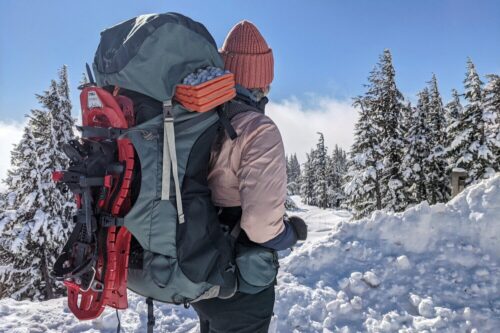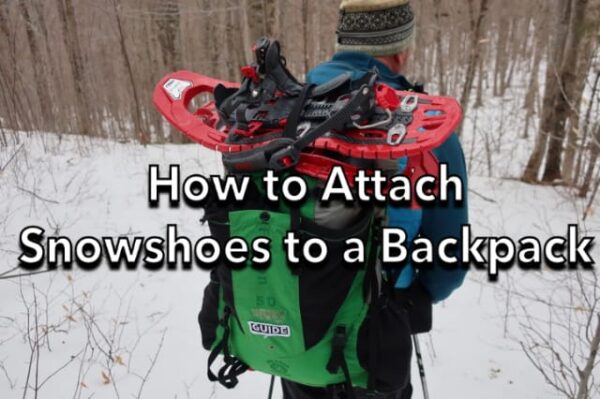How to Carry Snowshoes on Your Backpack is challenging for winter hikers. Winter hiking and snowshoeing can be incredible adventures, providing opportunities to explore snow-covered landscapes and enjoy the beauty of nature. However, one challenge that many winter hikers face is how to carry their snowshoes effectively. Carrying snowshoes in your backpack is a convenient and efficient way to transport them while keeping your hands free. In this article, we will guide you through the process of carrying snowshoes in your backpack, ensuring they are secure, well-balanced, and easily accessible.
Snowshoes are essential equipment for winter hiking and can greatly enhance your traction and stability in snowy and icy conditions. They allow you to distribute your weight over a larger surface area, preventing you from sinking into the snow. Carrying snowshoes in your backpack allows you to bring them along and easily switch between hiking with and without snowshoes as the terrain changes.
How to Carry Snowshoes on Your Backpack

Choosing the right backpack for carrying snowshoes
Before you can carry snowshoes in your backpack, it’s important to choose the right backpack that can accommodate them comfortably. Consider the following factors when selecting a backpack for this purpose.
Consider the size and capacity of the backpack
Ensure that the backpack you choose has enough space to accommodate your snowshoes. Snowshoes can vary in size, so check the dimensions of your snowshoes and compare them to the backpack’s dimensions. Additionally, consider the overall capacity of the backpack to ensure it can hold your other essential items as well.
Look for backpacks with external attachment options
Backpacks with external attachment points, such as loops, daisy chains, or straps, provide convenient options for carrying snowshoes. These attachment points allow you to secure the snowshoes externally, keeping the inside of your backpack clean and organized.

Consider the weight distribution and comfort
Carrying Snowshoes in your backpack adds extra weight, so it’s crucial to choose a backpack that distributes the weight evenly and provides proper support and comfort. Look for backpacks with padded shoulder straps and a hip belt to alleviate pressure on your shoulders and maintain stability.
Preparing snowshoes for backpacking
Before packing your snowshoes, it’s important to ensure they are in good condition and ready for the hike. Follow these steps to prepare your snowshoes.
1. Clean and dry the snowshoes
Remove any dirt, snow, or ice from your snowshoes before packing them. Wipe them down with a dry cloth and let them air dry to prevent moisture buildup that could lead to rust or damage.
2. Secure the bindings and check for any damages
Inspect the bindings of your snowshoes and ensure they are securely fastened. Check for any signs of wear or damage, such as loose straps or broken buckles. If you notice any issues, repair or replace the bindings before your hike.
3. Remove excess snow from the snowshoes
If there is snow accumulated on your snowshoes, remove it before packing them. Excess snow can add unnecessary weight and make the snowshoes more challenging to pack properly.
Packing snowshoes in the backpack
Now that your snowshoes are prepared, it’s time to pack them in your backpack. Follow these steps to ensure they are packed securely and won’t interfere with your hiking experience.
1. Utilize the external attachment points on the backpack
If your backpack has external attachment points, take advantage of them to secure your snowshoes. Attach the snowshoes to the loops, daisy chains, or straps, ensuring they are tightly secured.
2. Use a dedicated snowshoe bag or cover them with a protective layer
If your backpack doesn’t have external attachment points or you prefer additional protection for your snowshoes, consider using a dedicated snowshoe bag. Alternatively, you can cover the snowshoes with a protective layer, such as a waterproof bag or a large plastic bag, before placing them inside the backpack.
3. Secure the snowshoes tightly to prevent shifting
To prevent the snowshoes from shifting and creating discomfort or imbalance while hiking, ensure they are tightly secured. Use straps or compression systems available in your backpack to hold the snowshoes firmly in place.
Balancing the weight and stability
Proper weight distribution and stability are crucial when carrying snowshoes in your backpack. Follow these tips to achieve the right balance.
1. Positioning the snowshoes inside the backpack
Place the snowshoes vertically or horizontally inside the backpack, depending on the available space and your preference. Experiment with different positions to find the most comfortable and balanced configuration.
2. Adjusting the backpack straps for proper weight distribution
Before starting your hike, adjust the backpack straps to distribute the weight evenly across your shoulders, back, and hips. Tighten the shoulder straps and hip belt to secure the backpack firmly and minimize movement.
3. Ensuring the backpack doesn’t affect your balance while hiking
While carrying snowshoes in your backpack, pay attention to your balance and movement. If you notice any discomfort or imbalance, readjust the straps or snowshoe position to achieve a more comfortable and stable hiking experience.
Tips for carrying snowshoes during winter hikes
Carrying snowshoes in your backpack effectively requires some practice and attention. Consider the following tips to make the most of your snowshoe-carrying experience.

1. Practice putting on and taking off snowshoes
Before your hike, practice putting on and taking off your snowshoes a few times. This will familiarize you with the process and ensure you can efficiently transition between hiking with and without snowshoes when necessary.
2. Regularly check the attachment points and bindings
During your hike, periodically check the attachment points and bindings of your snowshoes. Ensure they are secure and haven’t loosened due to movement or vibration. Tighten or adjust them if necessary to maintain stability.
3. Adjust the backpack straps if necessary during the hike
As you hike and your body temperature changes, you may need to adjust the backpack straps to maintain a comfortable fit. Loosen or tighten the straps as needed to avoid discomfort or restriction.
Essential Tips for Carrying Snowshoes on Your Backpack
- Ensure Proper Adjustment of Snowshoes
- Secure Snowshoes to Your Backpack
- Pack Snowshoes with Bindings Facing Out
- Stay Aware of Your Surroundings
- Embrace the Fun and Enjoyment of Snowshoeing
There are a few different ways to carry snowshoes on your backpack. The best method for you will depend on the size and type of your backpack, as well as the size and type of your snowshoes.
Here are a few methods you can use:
1. Front carry: This is a good option if your backpack has a front pocket or a set of compression straps that run across the front of the pack. To do this, simply place your snowshoes in the front pocket or secure them to the compression straps with bungee cords or straps. Make sure the snowshoes are facing the same direction and that the crampons are pointing out.
2. Side carry: This is another popular option. To do this, simply secure your snowshoes to the side of your backpack with bungee cords or straps. Make sure the snowshoes are facing the same direction and that the crampons are pointing out.
3. Top carry: This is a good option if your backpack has a top lid that is large enough to accommodate your snowshoes. To do this, simply place your snowshoes in the top lid and secure them with the lid’s compression straps.
4. Inside the backpack: This is a good option if you have a large backpack and you don’t want to carry your snowshoes on the outside. To do this, simply place your snowshoes inside the backpack and pack around them. Make sure the snowshoes are well-secured so they don’t move around and cause discomfort.
Conclusion
Carrying Snowshoes in your backpack provides a practical solution for winter hikers, allowing them to bring their snowshoes along without impeding their movements. By choosing the right backpack, properly preparing the snowshoes, and ensuring a balanced weight distribution, you can enjoy a seamless winter hiking experience. Practice putting on and taking off snowshoes, regularly check the attachment points and bindings, and make necessary adjustments to the backpack straps during your hike. With these tips in mind, you’ll be ready to conquer snowy trails and enjoy the beauty of winter landscapes.
FAQs – How to Carry Snowshoes in Your Backpack
1. Can I carry snowshoes in a regular backpack?
Yes, you can carry snowshoes in a regular backpack if it has enough space and external attachment points or compression systems to secure them properly. However, choosing a backpack specifically designed for outdoor activities and winter hiking can provide better support and convenience.
2. How do I prevent the snowshoes from damaging other items in my backpack?
To prevent the snowshoes from damaging other items in your backpack, use a dedicated snowshoe bag or cover them with a protective layer, such as a waterproof bag or a large plastic bag. This will create a barrier between the snowshoes and your other belongings.
3. Can I attach snowshoes to the outside of a backpack without external attachment points?
If your backpack doesn’t have external attachment points, you can use compression straps or bungee cords to secure the Snowshoes in the outside. Wrap the straps or cords around the backpack and the snowshoes, ensuring they are tightly fastened.
4. Are there any specific backpack features that are ideal for carrying snowshoes?
Backpacks with external attachment points, loops, daisy chains, or straps are ideal for carrying snowshoes. These features allow you to secure the snowshoes externally, keeping the inside of your backpack clean and organized.
5. Should I remove the snowshoes from my backpack while taking breaks?
It’s generally not necessary to remove the snowshoes from your backpack during breaks unless you need to access something inside the backpack. However, ensure that the snowshoes are securely fastened and won’t hinder your movements while taking a break.
Ameer Hamza is a dedicated fashion writer with a keen eye for emerging trends and a passion for the artistry of style. His work delves into the latest in fashion, offering readers insights on everything from runway-inspired looks to everyday elegance. With a flair for storytelling and a deep understanding of the industry, Ameer Hamza brings a fresh perspective, making high fashion accessible and inspiring to all. Follow along as he explores the intersection of creativity, culture, and couture in the ever-evolving world of fashion.
